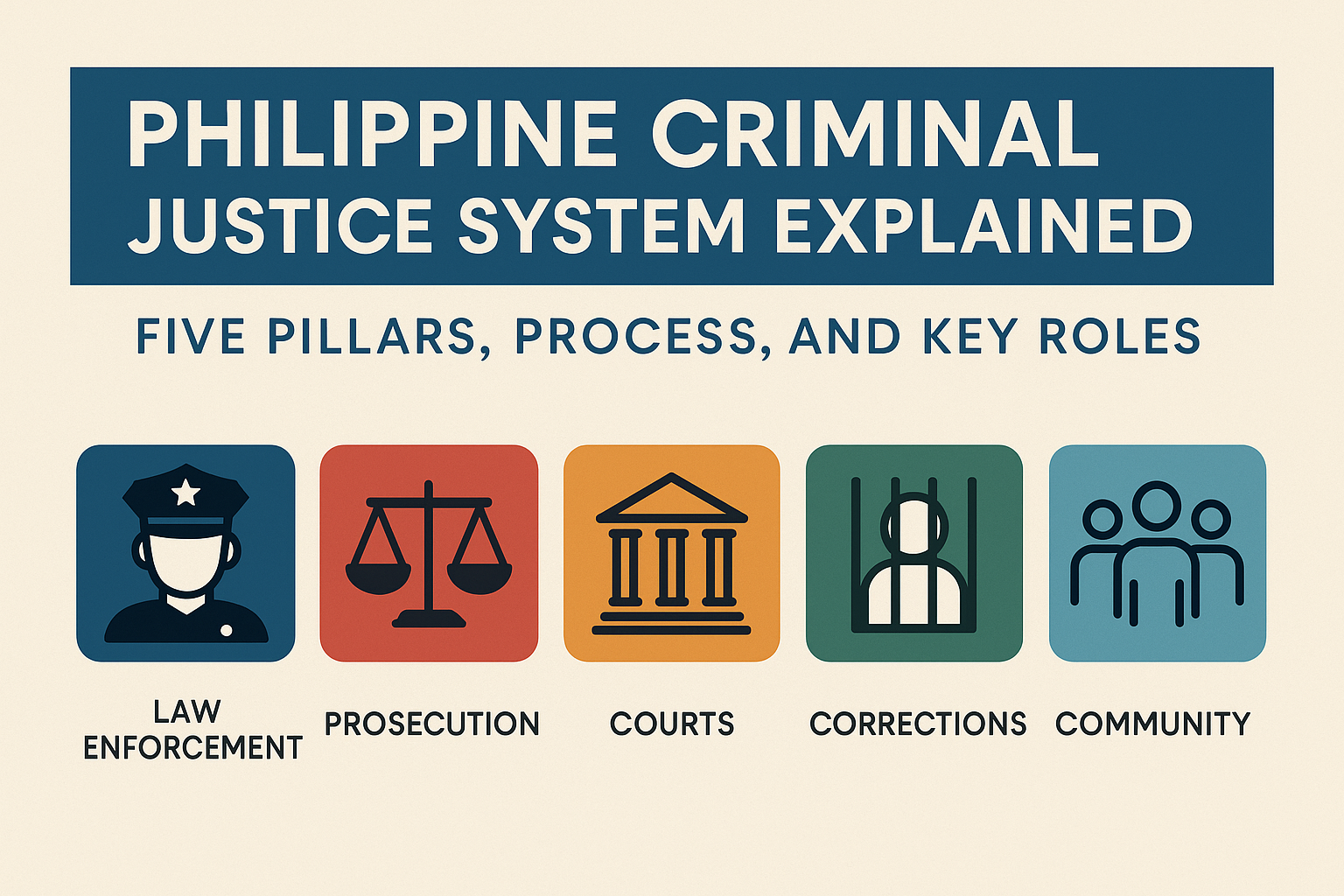Ever wondered how the criminal justice system works in the Philippines? Well, sit tight because we’re about to dive into the intricacies of the Philippine Criminal Justice System (PCJS). It’s like a well-oiled machine designed to maintain law and order in our society. At the heart of this system, we have what are known as the “five pillars.” Sounds intriguing, right?
The Five Pillars of the PCJS
The five pillars of the PCJS are essentially the backbone of this system. Constituting them are the police, prosecution, the courts, correctional institutions, and the community. Each of these has a unique role, but they all work towards the common goal of justice. Together, they form a cohesive structure that ensures that the rights of individuals are protected while maintaining peace and order in the community. Each pillar has its own set of responsibilities and operates within a framework governed by the rule of law, emphasizing fairness, accountability, and transparency.
The Role of the Police
The journey begins with the police, our first pillar. Picture them as the initiators or the prime movers of this justice system. When someone commits a crime, it’s the police who step in to file a complaint with the prosecutor. They are the ones who set the machinery of justice into motion. Their duties go far beyond simply arresting offenders; they also focus on preventing crimes, investigating incidents, and gathering evidence. For many—whether victims seeking redress or suspects facing charges—the police serve as the first point of contact with the justice system. This makes their role essential in shaping how the entire legal process unfolds thereafter.
The Prosecutor’s Role
Next up, we have the prosecutor, who takes over from the police. The primary duty of a prosecutor is to carry out a preliminary investigation, which involves assessing whether sufficient probable cause exists to bring a case to trial. If no probable cause is found, the complaint is dismissed; but if it is established, the prosecutor files the appropriate information before the court. In this way, prosecutors serve as vital guardians of the criminal justice system, tasked with representing the State in pursuing criminal actions. Their judgment and discretion not only influence the progress of cases but also bear profound consequences for both the accused and the victims. Their dedication to safeguarding justice—by prosecuting the guilty and protecting the innocent—remains essential to preserving the public’s confidence in the legal system.
Arrests and Warrants
Now, let’s talk about arrests. There are two types: arrest with a warrant and warrantless arrest (or citizen’s arrest). You might be thinking, “What’s the difference?” An arrest made with a warrant is fairly direct: the court issues the order, and law enforcement carries it out. In contrast, a warrantless arrest happens when the individual is apprehended in the very act of committing the offense. The distinction between these two types of arrests underscores the balance that the system seeks to maintain between individual rights and societal protection. The requirement for a warrant ensures that arrests are made based on probable cause and judicial authorization, while the allowance for warrantless arrests enables immediate action in situations where crimes are actively being committed.
The Court’s Role
Once the court gets involved, it issues a warrant of arrest. Afterward, an inquest proceeding is conducted by the prosecutor to decide whether the suspect should remain in custody. If everything checks out, the case moves forward to arraignment. Here, the accused enters a plea, and pre-trial conferences take place. The courts serve as the arena where justice is administered, and their role is pivotal in ensuring that trials are conducted fairly and impartially. Judges must adhere to the principles of due process, ensuring that both the prosecution and the defense have the opportunity to present their cases. The court’s decisions are based on the evidence presented, legal precedents, and the application of the law, with the ultimate goal of delivering a just and equitable judgment.
Pre-Trial and Trial
During pre-trial, various matters are ironed out, such as plea bargaining and the marking of evidence. It’s all about setting the stage for a fair and expeditious trial. If the accused admits guilt but has a lawful defense, the trial proceeds accordingly. It’s like laying out all the cards on the table before the main event. The pre-trial phase is critical as it helps streamline the issues for trial, which can lead to a more efficient judicial process. The trial itself is a structured process where the prosecution and defense present their arguments, examine witnesses, and submit evidence. The outcome of the trial, whether it results in conviction or acquittal, is determined based on the merits of the case as presented before the court.
Judgment and Corrections
After the trial, if the accused is found guilty, the judgment is passed. But the story doesn’t end there. The accused might file an appeal, and if the conviction stands, we move to the correction phase. Correction can be institutional or non-institutional, depending on the sentence. The correctional phase focuses on the rehabilitation and reintegration of offenders into society. The approach taken depends on the nature of the crime, the behavior of the offender, and the potential for rehabilitation. The correctional system aims to balance punitive measures with opportunities for reform, enabling offenders to become productive members of society upon their release.
Institutional and Non-Institutional Corrections
Institutional correction involves serving time in facilities like the Bureau of Corrections or the Bureau of Jail Management and Technology. Non-institutional correction, on the other hand, is community-based. It’s for those who receive lighter sentences, providing a chance for rehabilitation within the community. This approach promotes restorative justice, focusing on repairing the harm caused by criminal behavior and fostering reconciliation with victims and the community. Non-institutional corrections can include probation, community service, and other forms of supervised release, all designed to support the offender’s reintegration while ensuring public safety.
Parole and Pardon
Parole and pardon serve as avenues for individuals who have already served the minimum portion of their sentence to gain another chance at freedom. Parole is granted when an offender shows genuine reform and readiness to return to society. It allows the individual to spend the remaining years of their sentence within the community under supervision and subject to specific conditions. Pardon, on the other hand, is an act of clemency extended by the President, which may be conditional or absolute. Unlike parole, a pardon goes further by forgiving the offender of the legal consequences of the crime. Both mechanisms highlight the belief that people are capable of change and that society benefits from offering opportunities for redemption.
The Role of the Community
The final pillar of the criminal justice system is the community, whose role is indispensable in ensuring the successful reintegration of former offenders. Beyond punishment, justice also encompasses rehabilitation and reformation, and this is where community involvement becomes crucial. By opening doors to employment, extending social acceptance, and providing support systems, communities help reduce the likelihood of reoffending. Community-based programs and restorative justice initiatives foster understanding, encourage acceptance, and promote safer, more cohesive neighborhoods. When the community embraces reformed individuals and supports their journey back into lawful living, it contributes not only to personal transformation but also to the strengthening of society as a whole. You can find more information about community involvement in the prosecution of crimes from this UNAFEI report.
Conclusion
The Philippine Criminal Justice System is a multifaceted process built upon five interdependent pillars. Together, they ensure that justice is upheld while also keeping open the path to rehabilitation and renewal. Every pillar—whether law enforcement, the judiciary, corrections, or community involvement—carries its own function, yet all are interlinked in preserving order and upholding justice. More than just a system of punishment, it reflects a deeper commitment to restoring lives and preserving human dignity. Through reforms and ongoing adaptation, the system continues to respond to the needs of society while remaining faithful to the principles of justice, fairness, and human rights. It stands as a reminder that justice is not only about retribution but also about offering second chances and nurturing the potential for positive change.




